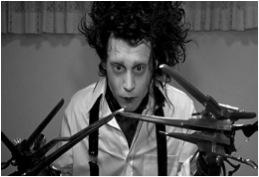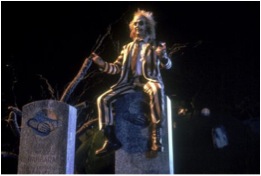Narrative Structure
Motif: there is definitely a character trait motif in films by Tim Burton in the way that he visually portrays his characters. In James and The Giant Peach, The Corpse Bride, and The Nightmare Before Christmas, there is definitely a significantly repeated element of his films by making the characters look gloomy and dark.
There is also a trait that is repeatedly shown through the use of color in his films. Edward Scissorhands, Beetlejuice, and The Corpse Bride are all heavily using the color gray. The use of the color gray and black are repetitively used as a motif is his films. This motif is used because Burtons genre is one of a dark nature. There is gloom and death is many of his films, and this is definitely evident of the color choices that he chooses.
Burton uses a strong narrative structure to pull together your emotional world into a fantasy world. ”Big Fish” tells the story of Edward Bloom, who is played by Albert Finney. (Edwards figure prominently in the Burton oeuvre — there’s Edward Scissorhands and the director Ed Wood and now Edward Bloom.) Bloom is a wild fabricator who has turned every incident in his life — from the birth of his child to his stint in the military to the wooing of his wife — into an elaborate tale. His estranged son, played by Billy Crudup, long tired of his father’s yarns, has nonetheless returned home to Alabama to reconcile with Bloom before he dies. ”Big Fish” jumps back and forth in time as Bloom, played as a young man by Ewan McGregor, spins his tales of wild adventures, some of which involve a giant, a pair of Siamese twins and a witch. Bloom is a mix of Odysseus, Candide and your long-winded uncle, and just when the movie seems in danger of veering off into the sentimental, Burton pulls it back. The extraordinary ending of ”Big Fish,” in which the son, finally, gets to tell his own story, is a perfect melding of the visual and the verbal: the words are bolstered, rather than overwhelmed, by Burton’s artistry.
Edward Scissorhands marks Barton’s return to fairy tale as the narrative structure for his films, but this time applied and manipulated in a sophisticated way, blended with humor and pathos, the lessons of his early TV work clearly well learned. Looking over his film output from the beginning to Big Fish, it is clear that the fairy-tale narrative structure suits him even better than that of animation; he would not use animation narrative structure again in live-action films except for Mars Attacks! Obviously, animation narrative and fairy-tale narrative have much in common, which perhaps excuses David Mills, one of the reviewers who picked up on the animated narrative structure in Burtons early films, for saying it applied to all of his films up to Sleep Hollow. In his films that used stop-motion animation, Burton returned to a combination genre-narrative with animation as the dominant narrative structure; In the Nightmare Before Christmas, the animation structure was combined with a fairy-tale structure.
In a German Expressionist book, I read that:
“Twentieth-century art is characterized by a growing disbelief in an objective reality. Emphasis has shifted from the outer world of empirical experience to the inner world that a man can test only against himself. As the subjective personality of the artistic has assumed control, it has demanded, in place of the old passive contemplation, an active participation from the observer. This is perhaps the most important single factor in the development of the expressionist movement.”
(Selz, 1974)
From this passage, I think you can definitely see the function of mise-en-scene from Burtons films birthing directly from the German Expressionist movement. Burton, time and time again, has characters that have experiences of an inner world that a man can test only against himself. Burton is constantly making characters that are in a world beyond our reality.
In a book about German Expressionism, I read:
“The German Expressionist movement arose out of a feeling of dissatisfaction with the existing order, and desire to effect revolutionary change. This attitude–rejecting bourgeois social values and the stale traditions of the state-sponsored art academies–was perhaps best reflected in Paul Klee’s 1903 etching Virgin in the Tree, a grotesque parody of the long convention of idealized or allegorical female nudes. In their efforts to tap into vital forces” or “inner feelings,” many Expressionists shared an interest in art of non-European or “primitive” cultures, which they felt offered a more immediate and authentic mode of expession, in contrast to centuries of academic refinement and placidity. Directness, frankness, and a desire to startle the viewer characterize Expressionism in its various branches and permutations.”
(Figura & Jelavich, 2011)
I find this to be particularly interesting in the fact that Burton tends to fit directly into this category of film-making. He seems to tap into inner feelings of his characters, and there is definitely an interest in non-traditional ways of making a scene or a film. From the sources that I have been reading, I believe that the mise-en-scene of Tim Burton films comes directly from German Expressionism.
Work Cited:
Figura, S., & Jelavich, P. (2011). German expressionism: The graphic impulse. The Museum of Modern Art.
Selz, P. (1974). German expressionist painting. London, England: University of California Press, Ltd.


